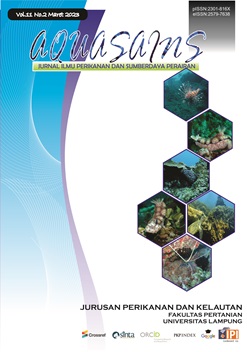THE EFFECT OF DIFFERENT REARING CONTAINERS COLORS ON THE COLOR BRIGHTNESS OF THE BARBIR FISH (Puntius conchonius)
DOI:
https://doi.org/10.23960/aqs.v11i2.p1287%20-%201296 Abstract View: 281
Abstract View: 281
Abstract
This study aims to to determine the container color that is effective in increasing the brightness of the color of Barbir fish (Puntius conchonius). The research was carried out from June to August 2022 at the Aquatic Animal Physiology Laboratory of the Faculty of Fisheries and Marine Sciences, Padjadjaran University. This study used a complete randomized block design (RAL) experimental method with five treatments and three replications. The treatment consisted of five treatments namely control A (colorless container), blue container (B), yellow (C), Green (D) and orange (E). The treatment is given for 60 days. Parameters observed include absolute length and weight growth, color brightness, survival rate and water quality (temperature, DO and pH). The results showed that the growth parameters with the highest value obtained in the orange background color treatment (treatment E, including the growth of absolute length of 0,27 ± 0,076 cm and the growth of absolute weight of 0,12 ± 0,014 g, as well as parameters of color brightness with an increase in color score in Toca color finder (TCF) reached 1.5 on the body; 1,8 on the serip chest; and 1,6 on the tail. The value of water quality parameters are in normal conditions (temperature ranges from 24,2-28oC; DO ranges from 5,8-8,5 mg/l; and pH ranges from 6,89-7,62) so that both the survival rate of Barbir fish that is equal to 100%.
Keywords: Puntius conchonius, container, background color, color brightness level, OrangeDownloads
References
Aras, A. K., Nirmala, K., Soelistyowati, D. T., & Sudarto. (2016). Manipulasi spektrum cahaya terhadap pertumbuhan dan kualitas warna yuwana ikan botia Chromobotia macracanthus ( Bleeker , 1852 ). Jurnal Iktiologi Indonesia., 16(1), 45–55.
Asih, S., & Huwoyon, G. . (2009). Domestifikasi Ikan Lokal Kalimantan Barat. Proseding Seminar Hasil Penelitian Perikanan Air Tawar 2010.
Boeuf, G., & Le Bail, P. Y. (1999). Does light have an influence on fish growth? Aquaculture, 177(1–4), 129–152. https://doi.org/10.1016/S0044-8486(99)00074-5
Cronin, T., Johnsen, S., Marshall, J., & Warrant, E. (2014). Visual ecology. Princeton University Press.
Effendi, I. (1997). Biologi Perikanan. Yayasan Pustaka Nusantara.
Gaspersz, V. (1991). Metode Perancangan Percobaan (Bandung). CV.ARMICO.
Giovani. (2003). Ketajaman mata ikan kakap merah terhadap alat tangkap pancing. Institut Pertanian Bogor.
Hafiz, M., Mutiara, D., Haris, R. B., Pramesthy, T. D., Mulyani, R., & Arumwati. (2020). Analisis Fotoperiode Terhadap Kecerahan Warna, Pertumbuhan Dan Kelangsungan Hidup Ikan Komet (Carassius auratus). Jurnal Ilmu-Ilmu Perikanan Dan Budidaya Perairan, 15(1), 1–9. https://doi.org/10.1016/j.sciaf.2019.e00146
Hawkes, J. W. (1974). The structure of fish skin - II. The chromatophore unit. Cell and Tissue Research, 149(2), 159–172. https://doi.org/10.1007/BF00222271
Lingga, P., & Susanto, H. (2003). Ikan Hias Air Tawar. Penebar Swadaya.
Madinawati, Serdiati, N., & Yoel. (2011). Pemberian pakan yang berbeda terhadap pertumbuhan dan kelangsungan hidup benih ikan lele dumbo (Clarias gariepinus). Media Litbang Sulteng, 4(2), 83–87.
Oshima, N. (2001). Direct Reception of Light by Chromatophores of Lower Vertebrates. Pigment Cell Research, 14(5), 312–319. https://doi.org/10.1034/j.1600-0749.2001.140502.x
Said, D. S., Supyawati, W. D., & Noortiningsih. (2005). Pengaruh jenis pakan dan kondisi cahaya terhadap penampilan warna ikan pelangi merah Glossolepis incisus jantan. Jurnal Iktiologi Indonesia, 5(2), 61–67.
Sulistyowati, R., & Rivai, M. (2008). Identifikasi jenis cairan dengan metode serapan panjang. 1, 339–343.
Susanto, H., & Lingga, P. (1989). Ikan Hias Air Tawar. Penebar Swadaya.
Van Der Salm, A. L., Martínez, M., Flik, G., & Wendelaar Bonga, S. E. (2004). Effects of husbandry conditions on the skin colour and stress response of red porgy, Pagrus pagrus. In Aquaculture (Vol. 241, Issues 1–4). https://doi.org/10.1016/j.aquaculture.2004.08.038
Woods, C. M. C. (2000). Improving initial survival in cultured seahorses, Hippocampus abdominalis Leeson, 1827 (Teleostei: Syngnathidae). Aquaculture, 190(3–4), 377–388. https://doi.org/10.1016/S0044-8486(00)00408-7

.png)










